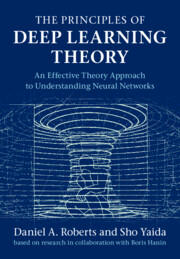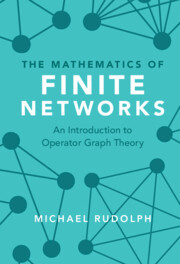2080 results in Statistical Physics
3 - Operator Calculus: The Mapping between Vector Spaces
- from Part I - Operator Graph Theory
-
- Book:
- The Mathematics of Finite Networks
- Published online:
- 30 April 2022
- Print publication:
- 12 May 2022, pp 88-116
-
- Chapter
- Export citation
2 - Classical Graph Theory: The Mathematical Description of Networks
- from Part I - Operator Graph Theory
-
- Book:
- The Mathematics of Finite Networks
- Published online:
- 30 April 2022
- Print publication:
- 12 May 2022, pp 13-87
-
- Chapter
- Export citation
Bibliography
-
- Book:
- The Mathematics of Finite Networks
- Published online:
- 30 April 2022
- Print publication:
- 12 May 2022, pp 327-332
-
- Chapter
- Export citation
Subject Index
-
- Book:
- The Mathematics of Finite Networks
- Published online:
- 30 April 2022
- Print publication:
- 12 May 2022, pp 336-342
-
- Chapter
- Export citation
4 - Operator Graph Theory: The Mathematics of Finite Networks
- from Part I - Operator Graph Theory
-
- Book:
- The Mathematics of Finite Networks
- Published online:
- 30 April 2022
- Print publication:
- 12 May 2022, pp 117-178
-
- Chapter
- Export citation
Afterthought
-
- Book:
- The Mathematics of Finite Networks
- Published online:
- 30 April 2022
- Print publication:
- 12 May 2022, pp 325-326
-
- Chapter
- Export citation
1 - Introduction
-
- Book:
- The Mathematics of Finite Networks
- Published online:
- 30 April 2022
- Print publication:
- 12 May 2022, pp 1-10
-
- Chapter
- Export citation
6 - Measuring Graphs
- from Part II - Applications
-
- Book:
- The Mathematics of Finite Networks
- Published online:
- 30 April 2022
- Print publication:
- 12 May 2022, pp 238-290
-
- Chapter
- Export citation
Part I - Operator Graph Theory
-
- Book:
- The Mathematics of Finite Networks
- Published online:
- 30 April 2022
- Print publication:
- 12 May 2022, pp 11-12
-
- Chapter
- Export citation
Contents
-
- Book:
- The Mathematics of Finite Networks
- Published online:
- 30 April 2022
- Print publication:
- 12 May 2022, pp vii-viii
-
- Chapter
- Export citation
Frontmatter
-
- Book:
- The Mathematics of Finite Networks
- Published online:
- 30 April 2022
- Print publication:
- 12 May 2022, pp i-iv
-
- Chapter
- Export citation
Part II - Applications
-
- Book:
- The Mathematics of Finite Networks
- Published online:
- 30 April 2022
- Print publication:
- 12 May 2022, pp 179-180
-
- Chapter
- Export citation
7 - Transforming Graphs
- from Part II - Applications
-
- Book:
- The Mathematics of Finite Networks
- Published online:
- 30 April 2022
- Print publication:
- 12 May 2022, pp 291-324
-
- Chapter
- Export citation
5 - Generating Graphs
- from Part II - Applications
-
- Book:
- The Mathematics of Finite Networks
- Published online:
- 30 April 2022
- Print publication:
- 12 May 2022, pp 181-237
-
- Chapter
- Export citation
Index of Notations
-
- Book:
- The Mathematics of Finite Networks
- Published online:
- 30 April 2022
- Print publication:
- 12 May 2022, pp 333-335
-
- Chapter
- Export citation
Dedication
-
- Book:
- The Mathematics of Finite Networks
- Published online:
- 30 April 2022
- Print publication:
- 12 May 2022, pp v-vi
-
- Chapter
- Export citation
Preface
-
- Book:
- The Mathematics of Finite Networks
- Published online:
- 30 April 2022
- Print publication:
- 12 May 2022, pp ix-xii
-
- Chapter
- Export citation

The Principles of Deep Learning Theory
- An Effective Theory Approach to Understanding Neural Networks
-
- Published online:
- 05 May 2022
- Print publication:
- 26 May 2022

The Mathematics of Finite Networks
- An Introduction to Operator Graph Theory
-
- Published online:
- 30 April 2022
- Print publication:
- 12 May 2022
Preface
-
- Book:
- The Statistical Physics of Data Assimilation and Machine Learning
- Published online:
- 27 January 2022
- Print publication:
- 17 February 2022, pp ix-xviii
-
- Chapter
- Export citation

